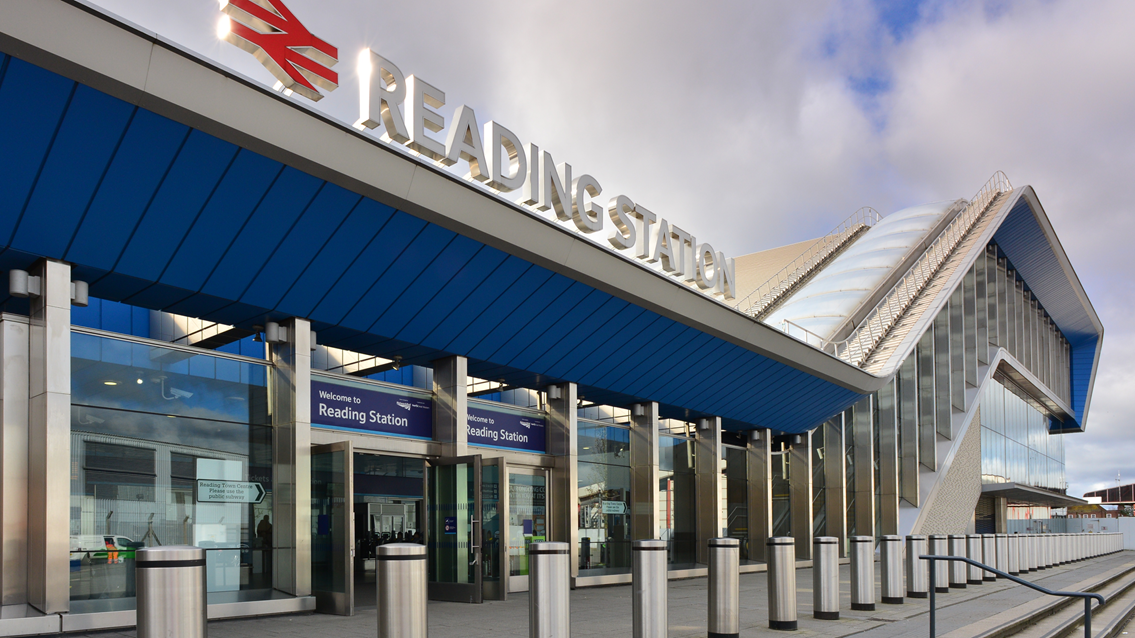Monday 13 Jun 2022
Reading station’s green credentials given boost thanks to ‘digital twin’
- Region & Route:
- Wales & Western
- | Wales & Western: Western
An innovative project to improve carbon emissions and energy performance at Reading station is underway which has the potential to improve the station’s energy performance by around 20%.
Sensors are set to be installed across Reading station to capture live, real-time data on the station’s energy usage in a bid to help cut the station’s carbon emissions and improve its energy performance.
This innovative approach to understanding and improving the station’s energy performance is thanks to a specialist computer modelling platform that has developed a ‘digital twin’ of the station including a simulation of its current energy usage. Using existing, historical data and modelling, a number of opportunities have been identified that are predicted could result in around a 20% improvement on the station’s carbon emissions and energy performance.
Network Rail has team up with Atkins – a member of the SNC-Lavalin Group – and Cardiff University to develop this ‘digital twin’ of Reading station, utilising Cardiff University’s Computational Urban Sustainability Platform (CUSP).
Using this data and computer modelling to create baselines for the station’s energy consumption and carbon emissions, CUSP has been used to map out ways of improving the station’s performance via energy efficiency measures whilst exploring further possible changes and the potential impact this could have on making additional energy savings.
A number of ways to reduce energy expenditure and carbon emissions with minimal costs have been identified, including:
- Improved lighting controls such as dimming when an area of the station is not in use.
- Turning off machinery such as escalators when not in use or overnight when train services aren’t in operation.
In addition to the data being collected by the sensors at the station, passenger numbers and research to understand passenger and station-user behaviour will also be recorded to understand how identified energy savings might impact their safety and experiences when in the station.
It is hoped, following the energy and carbon savings being realised at Reading station, this technology can be utilised across the rail network to support Network Rail in its commitment to reducing its carbon footprint.
Adam De Benedictis, Network Rail’s Regional Energy & Carbon Manager, said: “We’re delighted to be working with Atkins on this innovative project which will help us gain a better understanding of complex assets - such as Reading station - and their predicted performance, allowing us to confidently identify and deliver energy efficiency measures and ultimately manage our assets effectively.
“As an organisation, we are committed to reducing our carbon emissions and playing our part in helping combat global warming while ensuring passengers’ experiences in our stations and on our railways are safe, reliable and comfortable.”
Nick Tune, Technical & Technology Director at Atkins, said: “This is an important milestone as we look to harness data and technology to improve delivery at every stage of an asset’s life.
“Digital twins are the centrepiece of this shift which is giving us the information needed to not only identify opportunities to improve an asset’s energy performance but to interrogate future scenarios, explore further recommendations and tell us how those interventions will work with an unprecedented degree of certainty.”
Notes to Editors
Atkins and Cardiff University have been working in partnership for almost two years on a digital twin programme leveraging CUSP which creates digital twins of buildings, infrastructure and cities to improve the design, construction, operation and maintenance of buildings and assets.
Atkins’ work with Cardiff University and Network Rail adds to the digital twin solutions being delivered in the rail sector across the world – including the development of an operational digital twin for the Canada Line in Vancouver – and in other sectors including a project for Thames Water to undertake a discovery phase for a digital twin for Beckton Wastewater Treatment Works.
Contact information
Passengers / community members
Network Rail national helpline
03457 11 41 41
Latest travel advice
Please visit National Rail Enquiries
Journalists
Rob Breckon
Head of Communications - Eastern
Network Rail
07395 390759
rob.breckon@networkrail.co.uk
About Network Rail
We own, operate and develop Britain's railway infrastructure; that's 20,000 miles of track, 30,000 bridges, tunnels and viaducts and the thousands of signals, level crossings and stations. We run 20 of the UK's largest stations while all the others, over 2,500, are run by the country's train operating companies.
Usually, there are almost five million journeys made in the UK and over 600 freight trains run on the network. People depend on Britain's railway for their daily commute, to visit friends and loved ones and to get them home safe every day. Our role is to deliver a safe and reliable railway, so we carefully manage and deliver thousands of projects every year that form part of the multi-billion pound Railway Upgrade Plan, to grow and expand the nation's railway network to respond to the tremendous growth and demand the railway has experienced - a doubling of passenger journeys over the past 20 years.
Follow us on Twitter: @networkrail
Visit our online newsroom: www.networkrailmediacentre.co.uk

